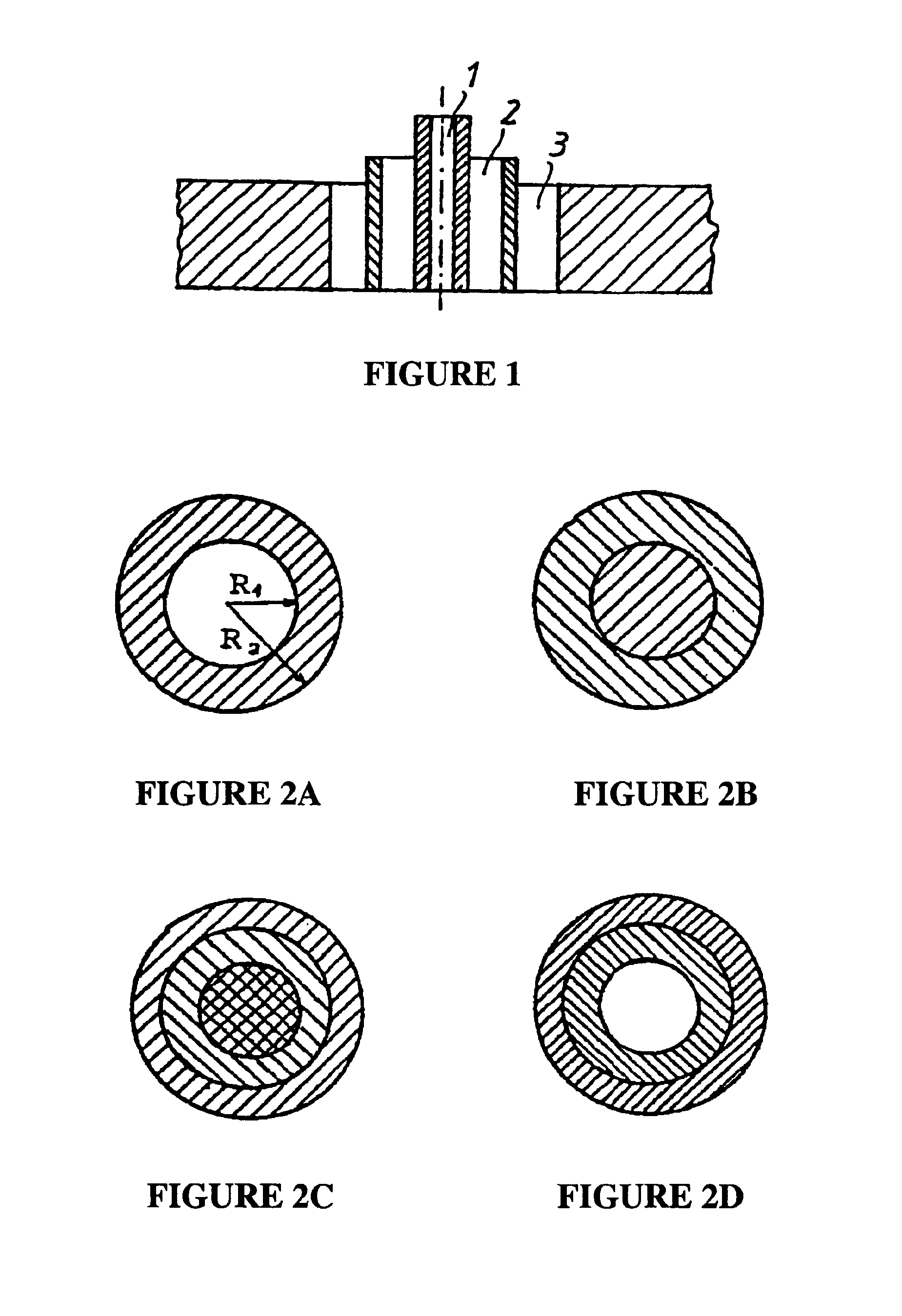Method for producing shaped bodies
a technology of shaped bodies and shaped bodies, applied in the direction of inorganic material artificial filaments, conjugated artificial filaments, lamination, etc., can solve the problems of loss of spinability, limitation of the number of possible additives, and the procedure in the described form does not enable the manufacture of multiple-layer, functional threads
- Summary
- Abstract
- Description
- Claims
- Application Information
AI Technical Summary
Benefits of technology
Problems solved by technology
Method used
Image
Examples
example 1
[0023]Aluminum oxide with an average particle size of 0.7 μm is added to a 7.5% w / w polysaccharide solution (8 parts cellulose, 2 parts amylose) in N-oxide-N-oxide monohydrate in a percentage by weight of 500% w / w relative to the cellulose share. In like manner, a solution is prepared having aluminum oxide with an average particle size of 3.6 μm in the same proportions. Both solutions are extruded at a temperature of approx. 100° C. through a double-slit hollow core nozzle in a ratio of 1:1, wherein the same volumetric percentage of water is pumped through the inside of the nozzle to achieve hollow structures. The nozzle was situated a distance of 10 cm away from the aqueous precipitation bath. The bi-component hollow filaments spun in this way without any additional pull-off were repeatedly extracted with warm water and then dried at room temperature under a constant load. The resulting materials had a outside diameter of approx. 1 mm. Drying was followed by sintering at 1500° C. T...
example 2
[0024]Aluminum oxide with an average particle size of 0.7 μm is added to a 7.5% w / w cellulose solution in N-oxide-N-oxide monohydrate in a percentage by weight of 250% w / w relative to the cellulose share. In like manner, a solution is prepared having an aluminum oxide with an average particle size of 1.2 μm relative to the cellulose share of 500% w / w. Both solutions are co-extruded at a temperature of approx. 90° C. at a ratio of core to jacket of 3:1, and relayed to a water bath vertically over a 15 cm long air gap. During extrusion, a quantity of water corresponding to the volume flux of both pumps is pumped inside the nozzle. The raw filaments spun in this way are stripped of solvent through repeated extraction with warm water, and dried at room temperature for several hours. After sintering at 1450° C., pore sizes of 450 or 200 nm result for the core and jacket layer. (FIG. 2D).
example 3
[0025]Aluminum oxide with an average particle size of 0.7 μm is added to a 9% w / w cellulose solution in N-oxide-N-oxide monohydrate in a percentage by weight of 700% w / w relative to the cellulose share. This solution is extruded together with a 9% w / w pure polysaccharide solution (amylose:cellulose=1:1) in N-oxide-N-oxide monchydrate at 105° C. at a ratio of core to jacket of 1:1 through a double-slit nozzle into a monofilament thread, wherein the uncharged solution is passed through the central borehole. The pull-off rate measured 25 m / min. The nozzle was situated a distance of 3 cm away from the aqueous precipitation bath. The exiting thread was passed through a precipitation bath 2 m long and then wound. After the thread is dried at room temperature, sintering takes place at 1450° C., and a hollow structure is formed by complete pyrolysis of the cellulose inside the bi-component filament, wherein the remaining jacket layer exhibits an average pore size of 150 nm. (FIG. 2A).
PUM
| Property | Measurement | Unit |
|---|---|---|
| particle size | aaaaa | aaaaa |
| temperature | aaaaa | aaaaa |
| particle size | aaaaa | aaaaa |
Abstract
Description
Claims
Application Information
 Login to View More
Login to View More - R&D
- Intellectual Property
- Life Sciences
- Materials
- Tech Scout
- Unparalleled Data Quality
- Higher Quality Content
- 60% Fewer Hallucinations
Browse by: Latest US Patents, China's latest patents, Technical Efficacy Thesaurus, Application Domain, Technology Topic, Popular Technical Reports.
© 2025 PatSnap. All rights reserved.Legal|Privacy policy|Modern Slavery Act Transparency Statement|Sitemap|About US| Contact US: help@patsnap.com

